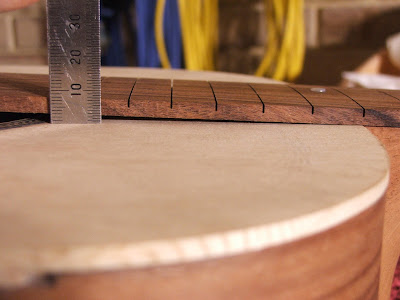I don't get to play any of my guitars enough these days. Somewhat because I am always building but of late my left hand has suffered a decent injury each week. Today I sliced my little finger open on the sharp fretboard edge. I can't play but I can build.
Breaking every rule of building in relation to humidity, I had an interesting evening in the shed. When the temperature dropped enough, I braved going down to the shed. As I worked a huge thunder storm rolled in off the ocean, lightening claps and thunder bolts followed by some serious rain and then - the power went out. I considered working under candle light but then thought better off it.
Maybe it was the lightening, but I am having some troubles with my digital camera, most of the photos I took today are corrupt in someway, they have squiggles across them etc and are no good. Only a few worked out.
I started on the fretboard when the power came back on. I marked a centre line and then used the neck to rough out the shape, as I did with the Stewmac method. Then I used a plane to work roughly down to the final shape of the fretboard.
Then I turned the fret board over and put tape on the 5th, 7th, 9th, 12th and 15th frets so I could mark the places for mother of pearl fret markers. I used tape as a depth gauge on a 5mm drill bit, drilled the holes and then glued the MOP in with a little epoxy. In hindsight, I should have gone with gold mother of pearl dots. It won't make a huge difference but I have gold tuners and a gold inlay in the head plate (pending).

I have (I think) repaired the blue with the neck block, I bought some 8mm thick dowel from the hardware store, sanded it down to 7.5 and glued it in place. I made a template of the tenon with masking tape on which I marked a centre line and the position of the bolts. I then put the tape into the mortise and bingo, I had the places marked where the new holes needed to be drilled.
Tomorrow, I'll be re-reading the information about sanding down the area where the fretboard meets the soundboard. I am getting confused as what steps I need to take here. Do I have to make adjustments as I did with the stewmac neck?
I found Andy. One of us is having trouble with our email but it is all sorted out now and my "W" will be here very soon. One question I am left with is, where are you Greg? You haven't added to your blog in almost a month. Hope all is well.
Time taken : a few hours
Tools used : rulers, glue, files, chisels, plane, sandpaper, epoxy, drill press and bits
AU$'s spent : $1.50 for the dowel


































